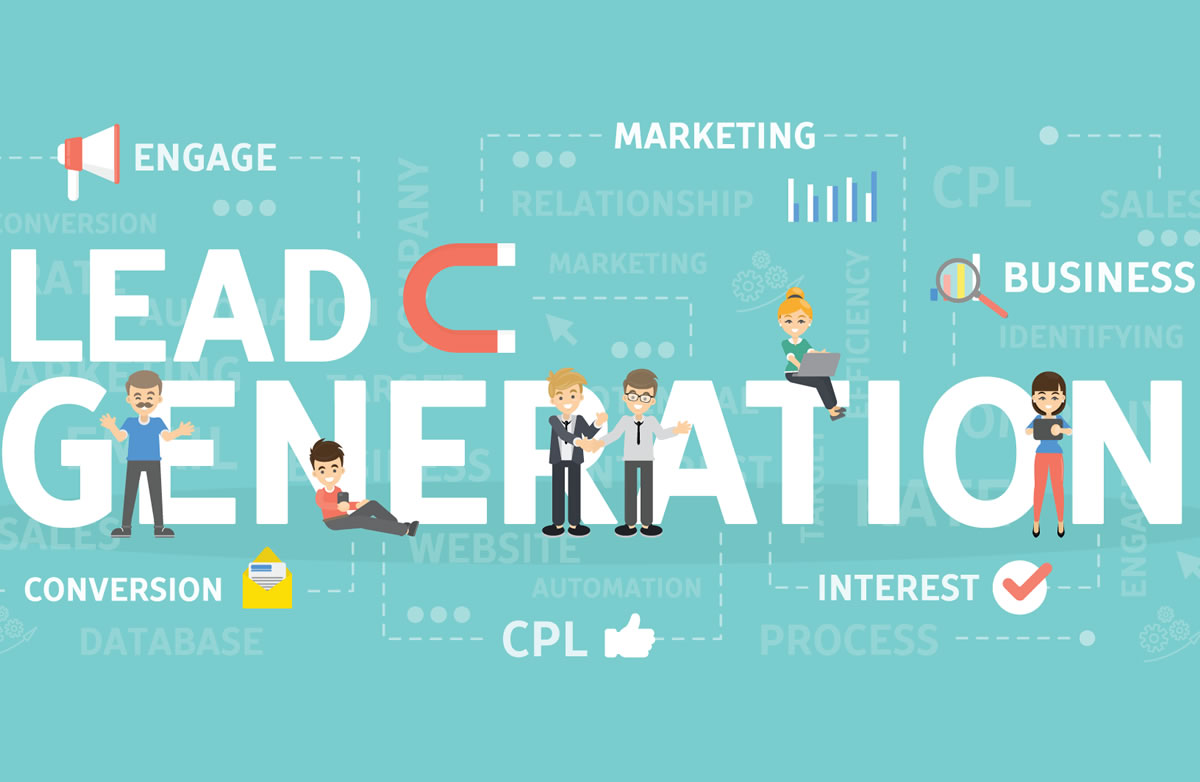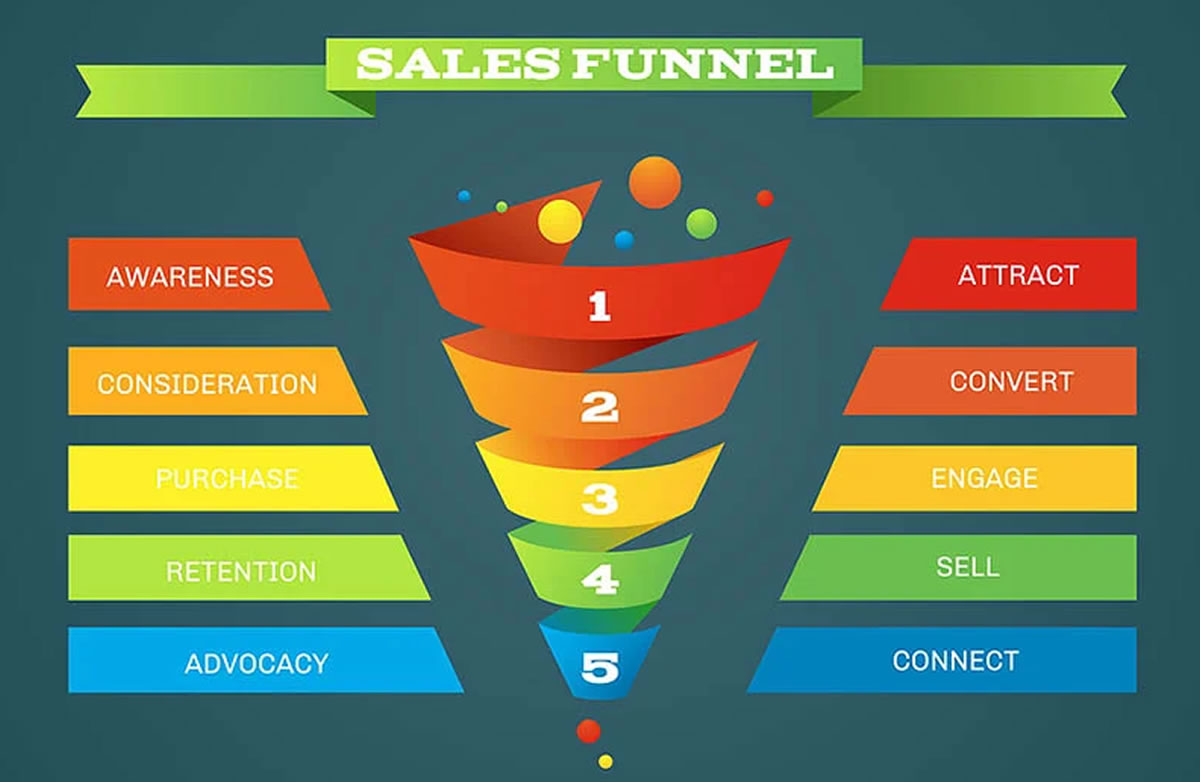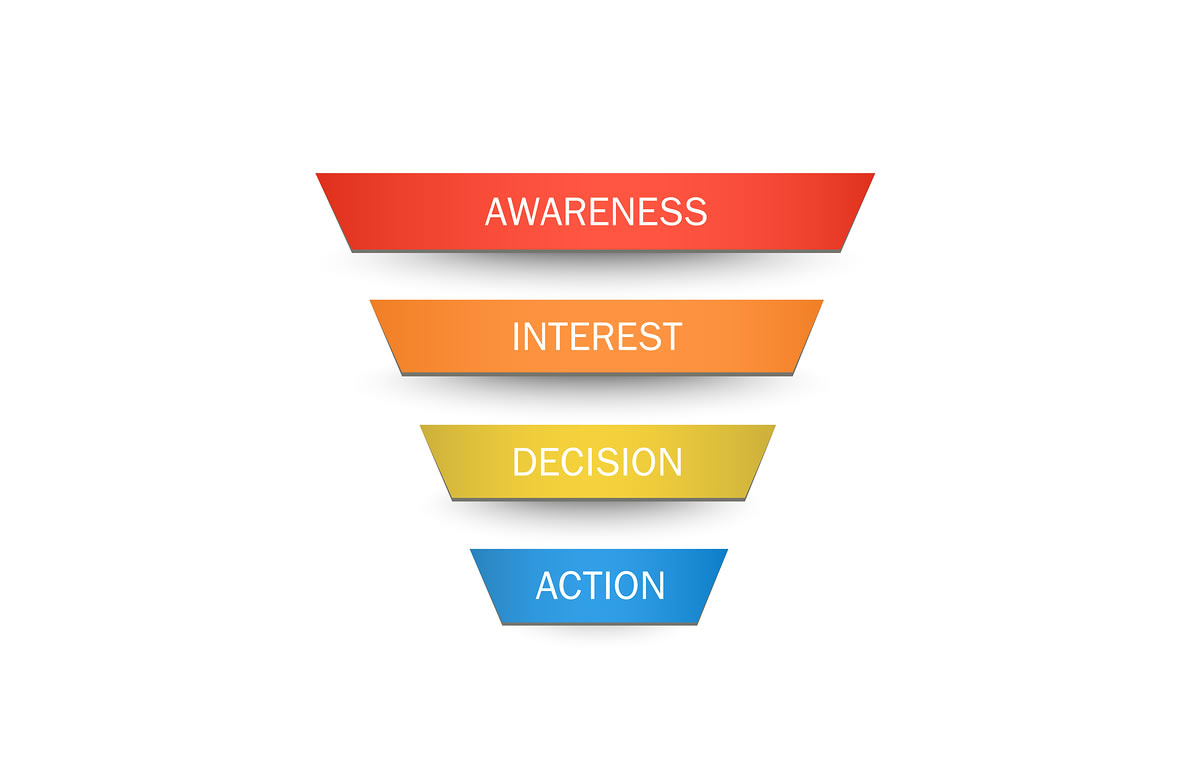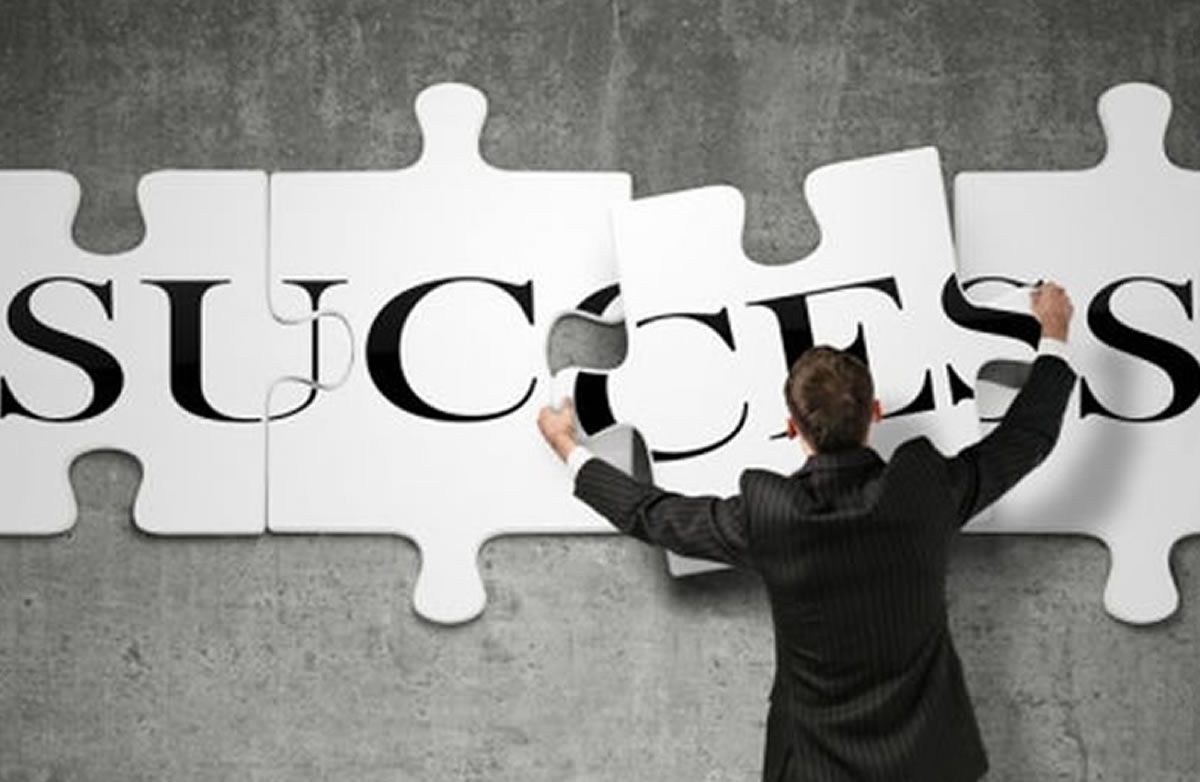
What is a Sales Funnel
Each of the sales funnel stages has an impact on consumer behavior. You need to know them intimately.
By knowing each step, you can use tactics to improve the number of people that go from one step to the next.
This can have a crazy impact on your business.
Let’s say you double the number of people at 2 steps of your funnel. You double leads and you double the percentage of closed customers. That gives you 4X the number of new customers every month.
Defining and managing your sales funnel is one of the most powerful concepts in business.
Let’s dive in.
Defining and managing your sales funnel is one of the most powerful concepts in business.
What is a Sales Funnel?
The sales funnel is each step that someone has to take in order to become your customer.
Let’s look at a brick and mortar sales funnel.
The people at the top of the sales funnel walk by your store. A certain percentage of them decide to walk in, that’s the next next of the funnel.
A customer sees a rack of T-shirts on clearance. He or she thumbs through the rack, now they’re at the next step of the funnel. Then the customer selects four t-shirts and walks to the checkout. They’re at the last step. If all goes well, they finish the purchase and reach the bottom of the funnel.
This same process plays out for every business in one way or the other. Your sales funnel could exist as:
- Retail store
- Sales team
- Website
- Personal consultation
Any marketing channel can be part of your sales funnel. And your funnel might be spread across several channels.
Why is a sales funnel important?
Your sales funnel illustrates the path prospects take.
Understanding your funnel can helps you find the holes in the funnel the places where prospects drop out and never convert.
If you don’t understand your sales funnel, you can’t optimize it. We’ll go into the specifics of how the funnel works below, but for now, understand that you can influence how visitors move through the funnel and whether they eventually convert.

The Sales Funnel Explained: How it Works
While there are lots of words used to describe different sales funnel stages, we’re going to go with the four most common terms to explain how each stage works as a consumer goes from a visitor to a prospect to a lead to a buyer.
A visitor lands on your website through a Google search or social link. He or she is now a prospect. The visitor might check out a few of your blog posts or browse your product listings. At some point, you offer him or her a chance to sign up for your email list.
If the visitor fills out your form, he or she becomes a lead. You can now market to the customer outside of your website, such as via email, phone, or text or all three.
Leads tend to come back to your website when you contact them with special offers, information about new blog posts, or other intriguing messages. Maybe you offer a coupon code.
The sales funnel narrows as visitors move through it. This is partially because you’ll have more prospects at the top of the funnel than buyers at the bottom, but also because your messaging needs to become increasingly targeted.

Understand the 4 Sales Funnel Stages
It’s easy to remember the four sales funnel stages by the acronym AIDA: Awareness, Interest, Decision, and Action. These four stages represent your prospective customer’s mindset.
Each stage requires a different approach from you, the marketer, because you don’t want to send the wrong message at the wrong time. It’s kind of like a waiter asking you what you want for dessert before you’ve even ordered drinks and appetizers.
Let’s look at each stage in the sales funnel in more detail:
Awareness
This is the moment at which you first catch a consumer’s attention. It might be a tweet, a Facebook post shared by a friend, a Google search, or something else entirely. Your prospect becomes aware of your business and what you offer.
When the chemistry is just right, consumers sometimes buy immediately. It’s a right-place, right-time scenario. The consumer has already done research and knows that you’re offering something desirable and at a reasonable price.
More often, the awareness stage is more of a courtship. You’re trying to woo the prospect into returning to your site and engaging more with your business.
Interest
When consumers reach the interest stage in the sales funnel, they’re doing research, comparison shopping, and thinking over their options. This is the time to swoop in with incredible content that helps them, but doesn’t sell to them.
If you’re pushing your product or service from the beginning, you’ll turn off prospects and chase them away. The goal here is to establish your expertise, help the consumer make an informed decision, and offer to help them in any way you can.
Decision
The decision stage of the sales funnel is when the customer is ready to buy. He or she might be considering two or three options hopefully, including you.
This is the time to make your best offer. It could be free shipping when most of your competition charges, a discount code, or a bonus product. Whatever the case, make it so irresistible that your lead can’t wait to take advantage of it.
Action
At the very bottom of the sales funnel, the customer acts. He or she purchases your product or service and becomes part of your business’s ecosystem.
Just because a consumer reaches the bottom of the funnel, however, doesn’t mean your work is done. Action is for the consumer and the marketer. You want to do your best to turn one purchase into 10, 10 into 100, and so on.
In other words, you’re focusing on customer retention. Express gratitude for the purchase, invite your customer to reach out with feedback, and make yourself available for tech support, if applicable.

An Effective Sales Funnel Example
Imagine that you own an ecommerce business that sells vintage signs. You know that your target audience hangs out on Facebook a lot and that your target customers are males and females between 25 and 65 years of age.
You run a fantastic Facebook Ad that drives traffic to a landing page. On the page, you ask your prospect to sign up for your email list in exchange for a lead magnet. Pretty simple, right?
Now you have leads instead of prospects. They’re moving through the funnel.
Over the next few weeks, you send out content to educate your subscribers about vintage signs, to share design inspiration, and to help consumers figure out how to hang these signs.
At the end of your email blitz, you offer a 10 percent coupon off each customer’s entire first order. Bang! You’re selling vintage signs like crazy. Everyone wants what you’re selling.
Next, you add those same customers to a new email list. You start the process over again, but with different content. Give them ideas for gallery walls, advise them about how to care for their signs, and suggest signs as gifts. You’re asking them to come back for more.
There you have it:
- Awareness: You created a Facebook ad to funnel (pun intended) people to your website.
- Interest: You offer something of value in exchange for lead capture.
- Decision: Your content informs your audience and prepares them for a purchase.
- Action: You offer a coupon your leads can’t resist, then begin marketing to them again to boost retention.
How to Build a Sales Funnel Fast
You’re stoked now, right? You want to create a sales funnel now and fast. Don’t worry. It’s not as difficult as it might seem.
Step 1: Analyse Your Audience’s Behaviour
The more you know about your audience, the more effective your sales funnel becomes. You’re not marketing to everybody. You’re marketing to people who are a good fit for what you sell.
Sign up for a Crazy Egg account and start creating Snapshots. These user behaviour reports help you monitor site activity and figure out how people engage with your site.
Where do they click? When do they scroll? How much time do they spend on a particular page? All of these data points will help you refine your buyer personas.
Step 2: Capture Your Audience’s Attention
The only way your sales funnel works is if you can lure people into it. This means putting your content in front of your target audience.
Take the organic route and post tons of content across all of your platforms. Diversify with infographics, videos, and other types of content.
If you’re willing to spend more cash, run a few ads. The ideal place to run those ads depends on where your target audience hangs out. If you’re selling B2B, LinkedIn ads might be the perfect solution.
Step 3: Build a Landing Page
Your ad or other content needs to take your prospects somewhere. Ideally, you want to direct them to a landing page with a can’t-miss offer.
Since these people are still low in the sales funnel, focus on capturing leads instead of pushing the sale.
A landing page should steer the visitor toward the next step.
You need a bold call to action that tells them exactly what to do, whether it’s downloading a free e-book or watching an instructional video.
Step 4: Create an Email Drip Campaign
Market to your leads through email by providing amazing content. Do so regularly, but not too frequently. One or two emails per week should suffice.
Build up to the sale by educating your market first. What do they want to learn? What obstacles and objections do you need to overcome to convince them to buy?
At the end of your drip campaign, make an incredible offer. That’s the piece of content that will inspire your leads to act.
Step 5: Keep in Touch
Don’t forget about your existing customers. Instead, continue reaching out to them. Thank them for their purchases, offer additional coupon codes, and involve them in your social media sphere.

Measuring the Success of a Sales Funnel
Your sales funnel might need tweaks as your business grows, you learn more about your customers, and you diversify your products and services. That’s okay.
A great way to measure the success of your sales funnel is to track your conversion rates.
How many people, for instance, sign up for your email list after clicking through on a Facebook Ad?
Pay careful attention to each stage of the sales funnel
Are your capturing the attention of enough consumers with your initial content?
Do your prospects trust you enough to give you their contact information?
Have you secured purchases from your email drip campaign and other marketing efforts?
Do existing customers come back and buy from you again?
Knowing the answers to these questions will tell you where you need to tweak your sales funnel.
Why You Need to Optimize Your Sales Funnel
Here’s the truth: Your prospective customers have lots of options. You want them to choose your products or services, but you can’t force it. Instead, you have to market efficiently.
Without a tight, optimized sales funnel, you’re just guessing about what your prospects want. If you’re wrong, you lose the sale.
Use Crazy Egg Recordings to watch how people engage with your site during a session. Where do they click? Does anything seem to confuse them? Are they focusing their attention where you want?
This is particularly important for those landing pages we talked about. If they’re not optimized for conversions, most people will just click away.
How to Optimize Your Sales Funnel
You can optimize your sales funnel in myriad ways. The most important places to put your focus are on the areas when consumers move to the next point in the funnel.
We talked about Facebook Ads. Don’t run just one ad. Run 10 or 20. They might be very similar, but direct them to different buyer personas and use Facebook’s targeting features to make sure those ads appear in front of your target audience.
A/B test your landing pages. It takes time, but you’ll reach more people and convert prospects more reliably.
You can also A/B test your email campaigns. Change up your language, imagery, offers, and layouts to figure out what your audience responds to.
The best way to optimize your sales funnel, though, is to pay attention to the results.
Start with the top of the funnel. You’re creating content, whether paid or organic, to get eyeballs on your brand and to encourage people to click on your CTA. If one piece of content doesn’t work, try something else.
Move on to your landing page. Make sure the offer and CTA mimic the content in your blog post or Facebook Ad, or whatever other asset you used to drive traffic there. Test your headline, body copy, images, and CTA to find out what works best.
When you ask people in the Action stage to buy from you, A/B test your offer. Does free shipping work better than a 5 percent discount? These little things can make a huge difference in your revenue.
And finally, track your customer retention rate. Do people come back and buy from you a second, fifth, and twentieth time? Do they refer their friends?
Your goal is to keep your brand top-of-mind. If you never disappoint your audience, they won’t have a reason to look elsewhere.
Conclusion
Creating and optimizing a sales funnel takes time. It’s hard work. But it’s the only way to survive in a competitive marketplace.
Believe it or not, a detail as small as font choice can impact conversions. And if you ask people to buy from you too quickly, you’ll chase them away.
Take time to build out a sales funnel that represents what you want and what your audience wants. Cultivate it over time, adjust your approach to various sales funnel stages, and find out why your efforts aren’t working.
Author: Safwan Ul Amin (Business Sales Director)
I have over 20 years experience in various business industries. Contact me on 02037332315 or [email protected] if you are thinking about buying or selling a business via our platform.
Sorry, the comment form is closed at this time.



